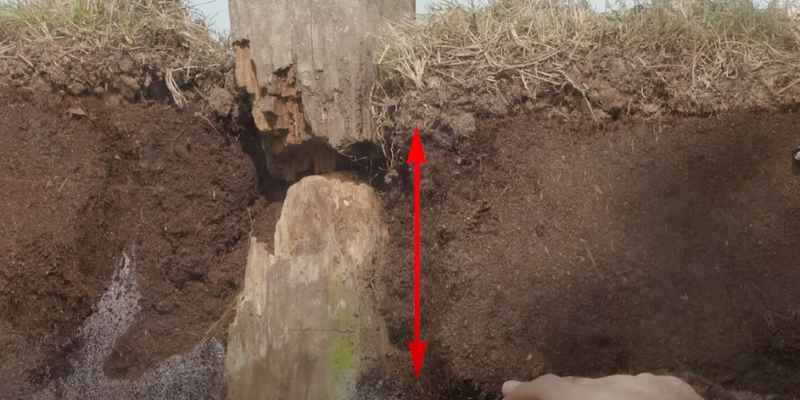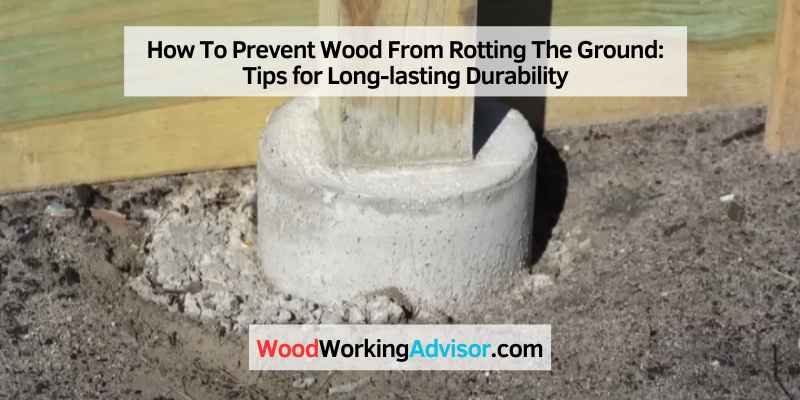To prevent wood from rotting in the ground, apply a wood preservative and use pressure-treated lumber. Ground contact should be avoided whenever possible, and proper drainage should be maintained to prevent water accumulation around the wood.
Introduction (120 words): Wood is a versatile and widely used material in various construction projects, but it is susceptible to rot when exposed to moisture and the elements. This deterioration can significantly compromise the structural integrity and lifespan of the wood.
To ensure the longevity of wood in ground contact situations, it is essential to take preventative measures against rot. We will explore effective strategies to prevent wood from rotting in the ground. By following these steps, you can protect your wood from decay and moisture damage, ultimately saving time, effort, and money in the long run. So, let’s dive in and discover how to preserve wood and keep it in top condition when in contact with the ground.
Choosing The Right Type Of Wood
Choosing the right type of wood is crucial for preventing rotting when it’s in direct contact with the ground. Properly treated woods like cedar or redwood are great options as they are naturally resistant to decay and can withstand moisture exposure.
One of the key factors in preventing wood from rotting in the ground is choosing the right type of wood. Not all wood species are equal when it comes to durability and resistance to moisture and decay. By selecting the appropriate wood, you can significantly extend the lifespan of your outdoor wooden structures and prevent the costly damage caused by rot.
Consider Wood Species
When choosing wood for ground contact applications, it is essential to consider the natural resistance of the wood species. Some types of wood are naturally more resistant to rot than others due to the presence of natural preservatives. These preservatives act as a defense mechanism against decay-causing organisms, ensuring the wood remains intact and durable, even when in contact with the ground.
The following wood species are highly recommended for ground contact applications:
| Wood Species | Natural Resistance |
|---|---|
| Cedar | Durable and naturally resistant to decay and insect damage due to the presence of natural oils and preservatives. |
| Redwood | Highly resistant to decay and insects, thanks to its natural tannins and oils. |
| Black Locust | An incredibly dense and rot-resistant wood that can last for several decades in direct ground contact. |
| Pressure-Treated Pine | Treated with chemical preservatives to enhance its resistance to decay and insect attack. |
By opting for these wood species, you can ensure your outdoor wooden structures remain strong and stable, even when exposed to moisture and varying weather conditions.
Look For Treated Wood
If you are considering wood species that are not naturally resistant to decay, it is advisable to look for treated wood. Pressure-treated wood goes through a treatment process where chemical preservatives are forced into the wood fibers under high pressure. This treatment enhances the wood’s resistance to rot, insects, and fungi.
When purchasing pressure-treated wood, ensure that it is labeled for ground contact use (UC4A or UC4B). This ensures that the wood has received a sufficient amount of preservatives to withstand prolonged exposure to soil and moisture.
Remember, regardless of the wood species you choose, it is essential to properly maintain and protect the wood by applying a suitable sealant or wood preservative. This additional layer of protection will further enhance the wood’s durability and resistance to rot.

Proper Ground Preparation
Proper ground preparation is vital for preventing wood from rotting in the ground. By taking necessary precautions and ensuring a solid foundation, you can protect your wood structures from moisture and decay, increasing their lifespan and durability.
Before installing any wood structure in your garden or outdoor space, it is crucial to undertake proper ground preparation. This not only ensures the stability and longevity of the wood but also helps prevent rotting. By following a few essential steps, you can effectively protect your wooden structures and enjoy their beauty for years to come.
Clear The Area
The first step in proper ground preparation is to clear the area where the wood will be placed. Remove any vegetation, rocks, or debris from the designated spot. This process not only creates a clean surface but also eliminates potential sources of moisture and bacteria that can contribute to wood rot. Clearing the area also allows for easier inspection of the ground, ensuring the absence of any underlying issues that may affect the wood’s integrity.
Create A Drainage System
A well-designed drainage system is key to preventing wood rot. Excessive moisture can seep into the ground, causing the wood to absorb water and eventually rot. To combat this, consider creating effective drainage channels that direct water away from the area where the wood will be installed. One option is to dig a trench around the perimeter of the site and fill it with gravel, which promotes better drainage. Another option is to install a French drain, which involves digging a trench and placing perforated pipes surrounded by gravel. This system effectively redirects water away from the wood, minimizing moisture-related risks.
Proper Ground Preparation Checklist:
- Clear the designated area of vegetation, rocks, and debris.
- Inspect the ground for any underlying issues that may impact wood integrity.
- Create a drainage system to redirect water away from the wood.
- Consider digging a trench and filling it with gravel or installing a French drain.
Following these steps in proper ground preparation will greatly reduce the chances of wood rotting due to ground moisture. Take the time to ensure the stability and durability of your wooden structures, allowing you to enjoy their natural beauty without worry.
Using Protective Coatings
Protect wood from rotting in the ground with the use of protective coatings. These coatings provide a barrier against moisture, preventing decay and prolonging the life of the wood. Apply the coating evenly and ensure complete coverage for optimal protection.
Apply Water Repellent Sealant
One of the most effective ways to prevent wood from rotting when it comes into contact with the ground is to apply a water repellent sealant. This protective coating forms a barrier between the wood and moisture, preventing it from being absorbed and causing rot.
Here’s how you can apply water repellent sealant:
- Clean the wood surface thoroughly using a mild detergent and water.
- Rinse off any soap residue and allow the wood to dry completely.
- Apply the water repellent sealant evenly using a brush or roller, working in the direction of the wood grain.
- Make sure to cover all exposed surfaces, including the ends of the wood.
- Allow the sealant to dry according to the manufacturer’s instructions before exposing the wood to the ground.
Use Primer And Paint
In addition to water repellent sealant, another effective way to protect wood from rotting is to use primer and paint. These coatings provide an extra layer of protection against moisture, UV rays, and other environmental factors that can lead to decay.
Here’s how you can use primer and paint to prevent wood rot:
- Prepare the wood surface by sanding it lightly to remove any rough spots.
- Clean the wood using a mild detergent and water, and rinse off any residue.
- Apply a coat of primer to the wood, ensuring full coverage.
- Allow the primer to dry completely before applying the paint.
- Choose a high-quality exterior paint that is specifically formulated for wood.
- Apply two coats of paint, allowing each coat to dry before applying the next.
- Ensure that all exposed surfaces, including the ends of the wood, are thoroughly coated.
By following these steps and using protective coatings such as water repellent sealant, primer, and paint, you can significantly extend the lifespan of wood that is in contact with the ground, preventing rot and decay.
Maintaining Regular Maintenance
Prevent wood from rotting in the ground by regularly maintaining it. Regular inspection and treating with a wood preservative can help protect against moisture, fungi, and decay, ensuring the longevity of your wooden structures.
Regular maintenance is key to preventing wood from rotting in the ground. By inspecting for damage and keeping the wood clean, you can extend its lifespan and maintain its structural integrity. In this section, we will discuss the importance of these practices in detail.
Inspect for Damage
Regularly inspecting your wood for any signs of damage is crucial in preventing rot. Here are some steps you can take to ensure the wood remains in good condition:
1. Check for cracks and splits: Inspect the wood surface for any visible cracks or splits. These can allow moisture to seep into the wood, leading to rot. If you spot any, consider filling them with an appropriate sealant to prevent further damage.
2. Look for signs of mold or fungus: Mold and fungus thrive in damp environments and can accelerate wood decay. Be on the lookout for any discoloration or growth on the surface of your wood. If you notice any, promptly remove it and take measures to address the underlying moisture issue.
3. Assess the structural integrity: Check if the wood is still sturdy and shows no signs of sagging or weakening. Any indication of structural damage should be addressed immediately to prevent further deterioration.
Keep Wood Clean
Keeping the wood clean is another essential aspect of maintenance that can prevent rot. Here are some tips to ensure your wood remains free from dirt, debris, and moisture:
1. Regularly remove leaves and debris: Leaves and debris can accumulate on top of the wood, creating a moist environment that promotes rot. Regularly sweep or use a leaf blower to remove any debris from the surface.
2. Prevent water pooling: Ensure that water does not accumulate around the wood. Provide proper drainage to redirect water away from the vicinity of the wood, preventing moisture buildup.
3. Apply a protective finish: Consider applying a protective finish to the wood to create a barrier against moisture and harmful UV rays. This can help prolong the lifespan of the wood and keep it looking its best.
Remember, regular maintenance is crucial to prevent wood from rotting when it is in contact with the ground. By inspecting for damage and keeping the wood clean, you can ensure its longevity and continue to enjoy its beauty and functionality. Take the necessary steps to maintain your wood, and it will reward you with years of use and durability.

Alternative Solutions To Wood
Prevent wood from rotting on the ground with alternative solutions that offer durability and longevity. Explore innovative materials that resist moisture and decay, ensuring the longevity of your outdoor structures without compromising on aesthetic appeal.
Consider Composite Materials
One alternative solution to wood rotting in the ground is to consider using composite materials instead. Composite materials are made from a combination of wood fibers and plastic, creating a durable and long-lasting product that is resistant to rot.
Composite materials, such as composite decking or composite lumber, offer several advantages over traditional wood. Firstly, their composition makes them resistant to moisture, preventing rot from occurring altogether. Additionally, composite materials require minimal maintenance, saving you time and effort in the long run.
Composite materials come in various styles and colors, allowing you to choose an option that suits your aesthetic preferences. They are also available in different sizes and dimensions, making them versatile for a wide range of landscaping projects.
Explore Stone Or Brick Options
If you’re looking for an alternative solution to wood that will truly stand the test of time, stone or brick options could be the answer. Stone and brick are inherently resistant to rot, ensuring that your structure remains sturdy and intact for years to come.
When considering stone or brick options, you have several choices available. Natural stone, such as granite or limestone, offers a classic and timeless look. On the other hand, brick gives a more traditional and rustic feel.
Stone and brick also offer additional benefits beyond their rot resistance. They are both low-maintenance materials that do not require staining or sealing. Moreover, they have excellent durability and can withstand harsh weather conditions, providing a long-lasting solution for your outdoor projects.
In conclusion, when it comes to preventing wood from rotting in the ground, exploring alternative solutions such as composite materials, stone, or brick options can be highly beneficial. These alternatives not only provide superior durability and resistance to rot, but they also offer unique aesthetic qualities. Consider using composite materials for a low-maintenance and versatile solution, or explore the timeless beauty of stone or brick options.
Conclusion
Taking proper precautions to prevent wood from rotting in the ground is essential for maintaining the longevity and durability of your structures. By implementing techniques such as using pressure-treated wood, creating adequate drainage, and applying protective coatings, you can safeguard against moisture and fungal decay.
Regular maintenance and inspections are also crucial to identify any signs of rot early on. By following these guidelines, you can ensure that your wood remains stable and resilient in the long run.


